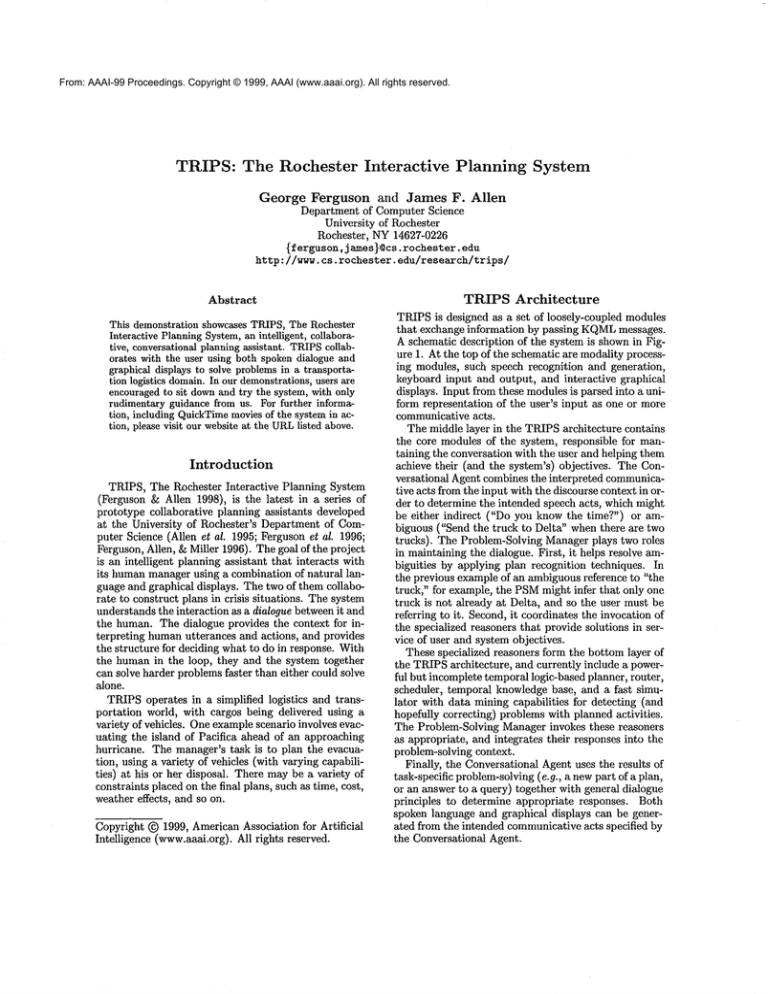TRIPS: The Rochester Interactive Planning System
advertisement

From: AAAI-99 Proceedings. Copyright © 1999, AAAI (www.aaai.org). All rights reserved.
TRIPS: The Rochester Interactive
Planning System
George
Ferguson
and James F. Allen
Department of Computer Science
University of Rochester
Rochester, NY14627-0226
{:f erguson, j ames}Ocs, rochester, edu
http ://www. cs. rochester, edu/research/trips/
Abstract
This demonstration showcases TRIPS, The Rochester
Interactive Planning System,an intelligent, collaborative, conversational planning assistant. TRIPScollaborates with the user using both spoken dialogue and
graphical displays to solve problems in a transportation logistics domain.In our demonstrations,users are
encouraged to sit downand try the system, with only
rudimentary guidance from us. For further information, including QuickTimemoviesof the system in action, please visit our website at the URLlisted above.
Introduction
TRIPS, The Rochester Interactive
Planning System
(Ferguson & Allen 1998), is the latest in a series
prototype collaborative planning assistants developed
at the University of Rochester’s Department of Computer Science (Allen et al. 1995; Ferguson et al. 1996;
Ferguson, Allen, &Miller 1996). The goal of the project
is an intelligent planning assistant that interacts with
its humanmanager using a combination of natural language and graphical displays. The two of them collaborate to construct plans in crisis situations. The system
understands the interaction as a dialogue between it and
the human. The dialogue provides the context for interpreting human utterances and actions, and provides
the structure for deciding what to do in response. With
the human in the loop, they and the system together
can solve harder problems faster than either could solve
alone.
TRIPS operates in a simplified logistics and transportation world, with cargos being delivered using a
variety of vehicles. One example scenario involves evacuating the island of Pacifica ahead of an approaching
hurricane. The manager’s task is to plan the evacuation, using a variety of vehicles (with varying capabilities) at his or her disposal. There may be a variety of
constraints placed on the final plans, such as time, cost,
weather effects, and so on.
Copyright © 1999, American Association for Artificial
Intelligence (www.aaai.org). All rights reserved.
TRIPS
Architecture
TRIPS is designed as a set of loosely-coupled modules
that exchange information by passing KQML
messages.
A schematic description of the system is shown in Figure 1. At the top of the schematic are modality processing modules, such speech recognition and generation,
keyboard input and output, and interactive graphical
displays. Input from these modules is parsed into a uniform representation of the user’s input as one or more
communicative acts.
The middle layer in the TRIPS architecture contains
the core modules of the system, responsible for mantaining the conversation with the user and helping them
achieve their (and the system’s) objectives. The Conversational Agent combines the interpreted communicative acts from the input with the discourse context in order to determine the intended speech acts, which might
be either indirect ("Do you know the time?") or ambiguous ("Send the truck to Delta" when there are two
trucks). The Problem-Solving Manager plays two roles
in maintaining the dialogue. First, it helps resolve ambiguities by applying plan recognition techniques. In
the previous example of an ambiguous reference to "the
truck," for example, the PSMmight infer that only one
truck is not already at Delta, and so the user must be
referring to it. Second, it coordinates the invocation of
the specialized reasoners that provide solutions in service of user and system objectives.
These specialized reasoners form the bottom layer of
the TRIPSarchitecture, and currently include a powerful but incomplete temporal logic-based planner, router,
scheduler, temporal knowledge base, and a fast simulator with data mining capabilities for detecting (and
hopefully correcting) problems with planned activities.
The Problem-Solving Manager invokes these reasoners
as appropriate, and integrates their responses into the
problem-solving context.
Finally, the Conversational Agent uses the results of
task-specific problem-solving (e.g., a newpart of a plan,
or an answer to a query) together with general dialogue
principles to determine appropriate responses. Both
spoken language and graphical displays can be generated from the intended communicative acts specified by
the Conversational Agent.
Microphone
Mouse Menu
Map
Displays Speakers
1
~mmun~llve
Acts (Input)
~mmun~tive
Acts (Output)
.....
=,e=’i°°a’
[
~/
°’=I
2rP~°b~em’S°lvi=g
I
Figure 1: TRIPS System Architecture
Key
Features
Space precludes a detailed discussion of TRIPScapabilities and shortcomings, so what follows is a just a quick
summary of some of the main features.
¯ Intuitive Interaction: The goal of the project is to
makeinteraction with intelligent systems like TRIPS
as natural as human conversation. The representation based on communicative acts and the structuring
of the interaction as a dialogue provide the structure
for intelligent interaction.
¯ Robust Understanding: One of the main thrusts
of our work on TRAINSand now on TRIPS has been
making the system robust. This includes handling
speech recognition errors, handling ungrammatical
or partial utterances, dealing with the system’s own
shortcomings gracefully, and, hopefully, even handling system errors and continuing the conversation.
¯ Recognition of User Intention: TRIPS explicitly
attempts to understand the intentions of the user in
understanding their utterances. This is used both
to resolve ambiguities and to provide useful or helpful responses. It can also drive the system into subdialogues to resolve problems.
¯ Intelligent
Plan Revision: We have found that
planning from scratch for goals is not the most important part of TRIPS.In the first place, it is impossible in practice for the user to fully specify their
goals in any reasonably complex domain. Thus they
will need to refine their plans as they discover new
constraints, add new objectives, and so on. Even if
the users knew exactly what they wanted, planning
is so hard that it is unlikely that we will be able to
do the planning in a reasonable amount time. The
best we could hope for would be approximate solutions that the user and the system can collaboratively
refine. Thus while we have developed some sophisticated planning techniques, they are incomplete compared to traditional planning algorithms but are also
much more flexible,
in order to accomodate human
guidance and incremental refinement.
¯ Simulation and Evaluation: We are investigating
the use of simulation to detect problems in plans, to
repair problems, to help monitor plan execution, and
to generate visualizations essential to humanunderstanding and evaluation of plans.
¯ Experimental Infrastructure:
TRIPS is designed
to be an experimental testbed. To this end, we
have built up a significant infrastructure to support
repeated experimentation, evalution, and analysis.
This includes, for example, the ability to replay sessions in real time, and to construct new, repeatable
scenarios for use in controlled experiments.
Acknowledgements
The TRIPS development team includes
Donna Byron, Amanda Stent, Lucian Galescu, and Myroslava
Dzikovska, in addition to the authors. Further thanks
are due to Len Schubert, and to the members of the
original TRAINSgroup from which TRIPS emerged.
TRIPS is funded in part by DARPA
research grant
no. F30602-98-2-0133,
USAF/RomeLaboratory research grant no. F30602-97-1-0348, ONRresearch grant
no. N00014-95-I-1088, and NSF research grant no. IRI9711009.
References
Allen, J. F.; Schubert, L. K.; Ferguson, G.; Heeman,
P.; Hwang,C. H.; Kato, T.; Light, M.; Martin, N. G.;
Miller, B. W.; Poesio, M.; and Traum, D. R. 1995.
The TRAINSproject: A case study in defining a conversational planning agent. Journal of Experimental
and Theoretical AI 7:7-48.
Fergnson, G., and Allen, J. F. 1998. TRIPS: An integrated intelligent problem-solving assistant. In Proceedings of the Fifteenth National Conference on AI
(AAAI-gS), 567-573.
Ferguson, G.; Allen, J.; and Miller, B. 1996. TRAINS95: Towards a mixed-initiative planning assistant. In
Drabble, B., ed., Proceedings of the Third Conference
on Artificial Intelligence Planning Systems (AIPS-96),
70-77.
Ferguson, G.; Allen, J. F.; Miller, B. W.; and Ringger, E.K. 1996. The design and implementation of the TRAINS-96 system: A prototype mixedinitiative planning assistant. TRAINSTechnical Note
96-5, Department of Computer Science, University of
Rochester, Rochester, NY.

